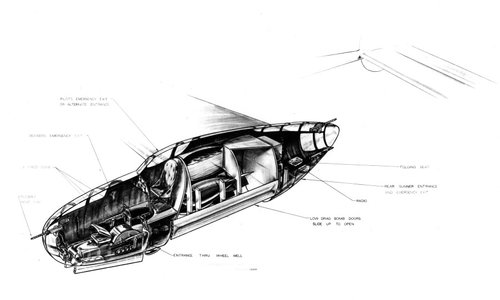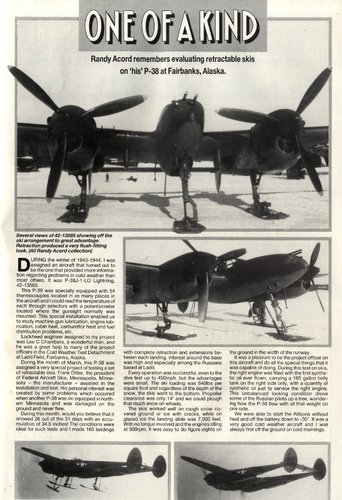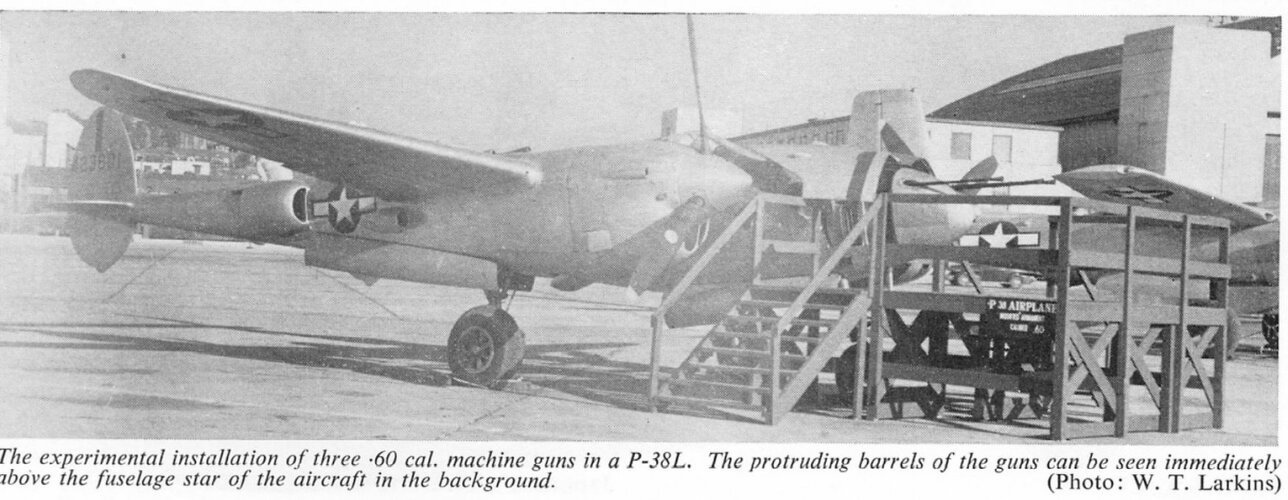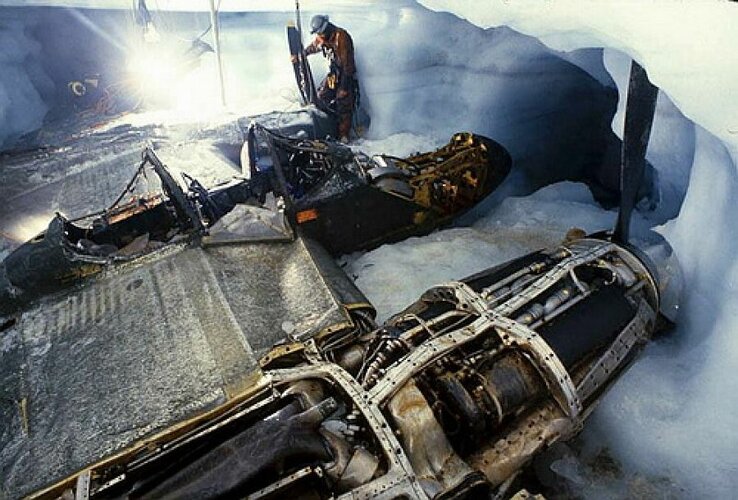You are using an out of date browser. It may not display this or other websites correctly.
You should upgrade or use an alternative browser.
You should upgrade or use an alternative browser.
Lockheed P-38 test planes and planned developments
- Thread starter GTX
- Start date
GWrecks
Big Wingy Thingy
- Joined
- 15 July 2018
- Messages
- 76
- Reaction score
- 19
sgeorges4 said:Preliminary lightning:

http://p38assn.org/Personnel/kelly-johnson.htm

http://imguramx.pw/Through-the-Pass-by-Heinz-Krebs-P38-Lightning-After-combat.html
That last one reminds me of a twin-boom Do 335. How long has push-pull been around, anyway?
- Joined
- 8 March 2009
- Messages
- 1,055
- Reaction score
- 1,293
GWrecks said:How long has push-pull been around, anyway?
Since at least WWI.
- Joined
- 2 January 2011
- Messages
- 345
- Reaction score
- 372
Push-pull has been around a lot longer than WWII. Take a look at the Dornier Do-X with SIX push-pull nacelles mounted on the top wing.
AlanG
AlanG
- Joined
- 26 May 2006
- Messages
- 34,872
- Reaction score
- 15,733
sgeorges4 said:Preliminary lightning:

http://p38assn.org/Personnel/kelly-johnson.htm

http://imguramx.pw/Through-the-Pass-by-Heinz-Krebs-P38-Lightning-After-combat.html
I sent all of those drawings before.
TomcatViP said:Picture extracted from this series of book:

Illustration from R. Watanabe I guess
Certainly ! Watanabe's illustrations are gorgeous. i have this book, plus I collected the ones for each planes published in France, Spit, Fw190, Bf109... by Editions Atlas.
I miss the ones on Mosquito, Lancaster and Stuka tho. Beautiful drawings.
The scale plans included are accurate in shape and beautiful too but are not "up to date" to latest researches though.
KJ_Lesnick
ACCESS: Top Secret
- Joined
- 13 February 2008
- Messages
- 1,042
- Reaction score
- 112
I didn't know it was Johnson's ultimate idea, but I do remember that a NACA report had proposed redesigning the gondola after-body, a redesigned radiator mounted in the wing-roots and a new cross-section.I wish I could see a drawing of what was reported as being Kelly Johnson's idea of the "ultimate P-38". It would've had the extended center nacelle of the "Lightning Swordfish", a bubble canopy, and the radiators and oil coolers mounted in the wing leading edge, much like those of the Mosquito.
Not entirely sure how bad it would be, as the radiators placed there would allow the area under the nacelle to carry the intercooler over there (like the J).I can see that they might have looked at putting the intercoolers there, too, but I can see several issues that would complicate that.
More than the P-38J did?In any case, such a redesign would've forced a considerable "hiccup" in production and was never authorized by the USAAF.
- Joined
- 8 March 2009
- Messages
- 1,055
- Reaction score
- 1,293
I didn't know it was Johnson's ultimate idea, but I do remember that a NACA report had proposed redesigning the gondola after-body, a redesigned radiator mounted in the wing-roots and a new cross-section.I wish I could see a drawing of what was reported as being Kelly Johnson's idea of the "ultimate P-38". It would've had the extended center nacelle of the "Lightning Swordfish", a bubble canopy, and the radiators and oil coolers mounted in the wing leading edge, much like those of the Mosquito.
Not entirely sure how bad it would be, as the radiators placed there would allow the area under the nacelle to carry the intercooler over there (like the J).I can see that they might have looked at putting the intercoolers there, too, but I can see several issues that would complicate that.
More than the P-38J did?In any case, such a redesign would've forced a considerable "hiccup" in production and was never authorized by the USAAF.
The Aviation HIstorian issue 23 has a good article about the extended center pod and the compressibility problem with the P-38. Lockheed apparently had two test mules modified with the extended fuselage section in 1941, prior to the swordfish. Serial number 40-747 and the first Lightning Mk1 (AE978)
Aubi
ACCESS: Secret
Push-pulls existed from the beginning of multi-engine aviation, there was one version of Ilya Muromets (D-1) with tandem engines in 1916, and I think Caproni had some too. Capronissimo of 1921 had eight engines - two pushers in separate gondolas, two "pullers" in separate gondolas, and two push-pull gondolas.
Temistocle
ACCESS: Secret
- Joined
- 9 December 2009
- Messages
- 245
- Reaction score
- 502
- Joined
- 9 October 2009
- Messages
- 21,944
- Reaction score
- 13,576
- Joined
- 8 January 2006
- Messages
- 1,610
- Reaction score
- 759
Can't you just see that in Soviet markings?
M. A. Rozon
ACCESS: Confidential
- Joined
- 17 February 2007
- Messages
- 121
- Reaction score
- 74
Love this book. Had it for many years and I routinely refer to it when building models of the subject aircraft.Picture extracted from this series of book:

Illustration from R. Watanabe I guess
- Joined
- 8 March 2009
- Messages
- 1,055
- Reaction score
- 1,293
I have no idea if this is actually P-38 related but it looks like it is. This is just listed as a Convair project(?!)

View: https://www.flickr.com/photos/sdasmarchives/35840427706/

View: https://www.flickr.com/photos/sdasmarchives/35840427706/
- Joined
- 19 July 2016
- Messages
- 4,270
- Reaction score
- 3,454
...or the performance of a turbo less P-38?
According Squadron Signal 1109 P-38 Lightning in Action, Model P-322 (Lightning MkI) could do 400 mph at 17000ft :
But, other sources says it was red lined at 300 mph, due to that very tailplane flutter problem the above Sqd/Sign book source says was solved on the P-322 (!) .
This from Lockheed P-38 Lightning Described, by Roy Cross , Kookabura:
And from Lockheed P-38 Lightning, by Jerry Scutts, Crowood :
I couldn’t find performance data on the unsupercharged P-322s (as P-38F-13/15 and G-15) used as trainers in the USAAF.
"Externally the P-322 Lightning; differs from the P-38 in the shape of the forward engine nacelle. With the installation of C series Allison engines, the propeller thrust line was lowered (as on the XP-38} The P-322 had oil cooler scoops in the nacelle fronts under the propellers (similar to the YP-38); however. the openings were slightly more streamlined, more circular in opening and further back on the nacelle than the YP-38/P-38-LO. The engine exhaust, instead of being routed back to the turbo-supercharger, exited through two exhaust stacks on the upper side of the nacelle over the wing The aircraft also had the larger radiator housings used on the P-38LO.
The center fuselage was identical to the P-38 except that it was outfitted with an RAF style control wheel. British radio equipment and other items of British specified supplied equipment I he RAF specified an armament of two .30 caliber machine guns and two .50 caliber machine guns, deleting the cannon armament of the P-38s.
The P-322 also had the retraction linkage arm on the nose wheel strut relocated from the front of the strut to the rear of the strut. This, in turn allowed the nose gear wheel well to be shortened and made more room available in the nose for ammunition. This feature was not incorporated on U.S P-38s until the P-38E.
finally, it was on the P-322 that the problem of tail bullet was finally solved After extensive tests. Kelly Johnson felt that it was disturbed airflow over the wing center section that caused the elevator flutter. He designed a set of wing root fillets for the juncture of the wing root and fuselage. The airflow was smoothed out and most of the elevator flutter problems were cured. The problem of compressibility, however, still remained.
Contracts with the British and french governments were for a total of 667 Lockheed Model 322 fighters It was the British that named the aircraft the Lightning during March of 1940. Both the British and French viewed the Lightning as a ground attack aircraft rather than a high altitude interceptor. The Model 322 with its unsupercharged engines offered a top speed in excess of 400 mph at 17.000 feet • much faster than the North American NA-73 Mustang
With the fall of France during early 1940. the RAF opted to pick up the remainder of the Model 322 contract. The first three P-322s were crated and shipped to England during 1942 for extensive tests at RAF Boscombe Down, the RAFs testing facility. RAF serial numbers reserved for the Lightning Is were AE 978-999 and AF 100-220.
In any event, the RAF decided that the Lightning did not meet their needs at the time and rejected the aircraft. It could have meant disaster for Lockheed to lose such a large contract; however, the US Army Air Force took over the P-322s that remained on the contract for use as P-38 trainers and for use in the defense of the Continental United States. Although the first twenty-three P-322s were completed equipped with the C series Allison engines, the remaining 120 aircraft were built with Allison V-I710-F2 engines with opposite rotation propellers. These aircraft were designated as Lightning Mk IIs and later redesignated as P-38F-13. F-15. and G-15. A total of 524 Model 322s were built."
But, other sources says it was red lined at 300 mph, due to that very tailplane flutter problem the above Sqd/Sign book source says was solved on the P-322 (!) .
This from Lockheed P-38 Lightning Described, by Roy Cross , Kookabura:
"In April 1940, long before the first YP-38 flew, the British had ordered 143 of a special export version, the Lightning I (L-322-61), with mechanically super charged V-1710-05 engines giving maximum military power of 1,090 h.p. at 13,200 ft. and with military equipment including armour plate and leakproof tanks. Without its turbo-supercharged engines the Lightning was shorn of its main asset, its excellent speed at over 20,000 ft., and had scant performance advantage over the manoeuvrable pleasant-handling Westland Whirlwind which had already been in limited service with the R.A.F. for some months when the first R.A.F. Lightnings were delivered early in 1942. The tail flutter and other troubles which caused the A.A.F. to impose a 350 m.p.h. speed restriction on early P-38 models resulted in a 300 m.p.h. speed limit in England. This was one of the reasons why the Lightning was never used in quantity by the R.A.F. "
And from Lockheed P-38 Lightning, by Jerry Scutts, Crowood :
"In the meantime, three of the original production Lightning Mk Is, AF105, AF106
and AF108, were shipped to England by sea, arriving in March 1942. It appears that
the Royal Aircraft Establishment (RAE) at Farnborough was the earliest recipient,
carrying out unspecified trials with AF108. This aircraft was passed to the USAAF in
Britain on 2 December 1942. Cunliffe-Owen took delivery of AF105 and similarly passed it to the USAAF
on I July 1943.
On 30 April 1942 AF106 arrived at the Aeroplane and Armament Experimental
Establishment (A&AEE) at Boscombe Down, Wiltshire, for brief handling trials.
The aircraft was unarmed and carried a speed restriction of 300mph (480km/h).
Flight trials were brief, as the RAF had little further interest in the type, but pilot
reports were generally positive, stating that handling was pleasant, though elevator
movement was described as heavy. The aircraft stalled at 78mph ( 125km/h) with flaps
and undercarriage down, the approach to the stall being described as straightforward.
Single-engine flight down to a speed of 115mph (185km/h) was also recorded as
comfortable. With the trials completed, AF106 was also transferred to the USAAF,
on 10 July 1943. Further use (if any) of this trio of hybrid Lightnings in the UK appears
to have gone unrecorded."
I couldn’t find performance data on the unsupercharged P-322s (as P-38F-13/15 and G-15) used as trainers in the USAAF.
- Joined
- 19 July 2016
- Messages
- 4,270
- Reaction score
- 3,454
Seconded, thank you, Sir.
There seems to be a bit of confusion here about the Model 322 Lightnings ordered by the British and French. 250 for Britain and 417 for France with the French order taken over by Britain in June 1940. At the time it was felt by Britain & France that the turbo-supercharger represented untried technology that would lead to delays in getting badly needed fighters into service. So they opted for supercharged Allison engines limiting performance above 15,000 feet. To increase commonality they had specified right handed engines only.
The Battle of Britain caused a re-evaluation of the order in light of combats at higher altitudes. Contracts with Lockheed were renegotiated in Spring 1941 and the RAF order became split. 143 Lightning I with supercharged right handed engines and 524 Lightning II with turbo-supercharged engines, broadly equivalent to the USAAF P-38E at that time.
Of the 143 Lightning I, 3 came to Britain as described above. The remaining 140 were taken over by the USAAF but retained their RAF serials. 19 retained supercharged engines (V-1710-C15 alternate designation V-1710-33) with unhanded props and were used for trials and training as RP-322-I. The remaining 121 were given handed engines (V-1710-27 & -29), still only supercharged, and designated P-322-II and used for training. I doubt that there would be any significant difference in performance between the two versions but handling in the latter would be easier. As training aircraft the lack of turbo-super chargers was a benefit to the inexperienced pilot as it was one less thing for him to worry about during the conversion process in what was a “hot ship”.
Production of the other 524 aircraft for the British/French orders had not begun when the contract was taken over by the USAAF at the beginning of 1942. So they ended up being built to then latest USAAF standard, as P-38F/G, with turbo-supercharged engines. Technically one was a Lightning II with an RAF serial but was still taken over by the USAAF as a P-38F-13. It was used for trials by Lockheed. The rest of the orders were completed as:-
28 P-38F-13-LO these may have retained British instrumentation in the cockpit.
121 P-38F-15-LO
174 P-38G-13-LO
200 P-38G-15-LO
I’ve not seen any evidence that those aircraft contracted as Lightning II but built as P-38F/G for the USAAF were restricted to training use.
Full details of all the Lightning versions can be found here:-
Edit:- The -G-13 & -G-15 we’re identical to the -G-3 & -G-5. They were given different block numbers as the orders originated from different contracts.
The Battle of Britain caused a re-evaluation of the order in light of combats at higher altitudes. Contracts with Lockheed were renegotiated in Spring 1941 and the RAF order became split. 143 Lightning I with supercharged right handed engines and 524 Lightning II with turbo-supercharged engines, broadly equivalent to the USAAF P-38E at that time.
Of the 143 Lightning I, 3 came to Britain as described above. The remaining 140 were taken over by the USAAF but retained their RAF serials. 19 retained supercharged engines (V-1710-C15 alternate designation V-1710-33) with unhanded props and were used for trials and training as RP-322-I. The remaining 121 were given handed engines (V-1710-27 & -29), still only supercharged, and designated P-322-II and used for training. I doubt that there would be any significant difference in performance between the two versions but handling in the latter would be easier. As training aircraft the lack of turbo-super chargers was a benefit to the inexperienced pilot as it was one less thing for him to worry about during the conversion process in what was a “hot ship”.
Production of the other 524 aircraft for the British/French orders had not begun when the contract was taken over by the USAAF at the beginning of 1942. So they ended up being built to then latest USAAF standard, as P-38F/G, with turbo-supercharged engines. Technically one was a Lightning II with an RAF serial but was still taken over by the USAAF as a P-38F-13. It was used for trials by Lockheed. The rest of the orders were completed as:-
28 P-38F-13-LO these may have retained British instrumentation in the cockpit.
121 P-38F-15-LO
174 P-38G-13-LO
200 P-38G-15-LO
I’ve not seen any evidence that those aircraft contracted as Lightning II but built as P-38F/G for the USAAF were restricted to training use.
Full details of all the Lightning versions can be found here:-
Edit:- The -G-13 & -G-15 we’re identical to the -G-3 & -G-5. They were given different block numbers as the orders originated from different contracts.
Last edited:
hey, can i download this picture and use it for my youtube purpose ? i will be insert your credit in the description later. thankssPerhaps a better view:

Regards,
Greg
klem
I really should change my personal text
- Joined
- 7 March 2015
- Messages
- 726
- Reaction score
- 1,633
Attachments
Speaking of the floatplane variant, the following is ready for release by Halberd models in Ukraine:






Hopefully they will be able to sell.






Hopefully they will be able to sell.
T. A. Gardner
ACCESS: Top Secret
- Joined
- 18 February 2021
- Messages
- 1,146
- Reaction score
- 2,007
The P-38K was to fit the RR Merlin XX.I have always been curious to know if there was ever a consideration to put RR Merlin and/or four bladed propellers on the P-38 ???
Fitting four bladed props and more powerful engines brought issues with them because of the P-38's compressibility issues. The speed of these proposed planes was such that the aircraft was close to the compressibility limits of the airframe in level flight.
Greg made a video, why the Merlin engines wouldnt have made an improvement for the P38:
View: https://www.youtube.com/watch?v=oJPGFcXRZZI&ab_channel=Greg%27sAirplanesandAutomobiles
- Joined
- 18 October 2006
- Messages
- 4,208
- Reaction score
- 4,901
Superb! Thank you. Insightful and well done.Greg made a video, why the Merlin engines wouldnt have made an improvement for the P38:
View: https://www.youtube.com/watch?v=oJPGFcXRZZI&ab_channel=Greg%27sAirplanesandAutomobiles
T. A. Gardner
ACCESS: Top Secret
- Joined
- 18 February 2021
- Messages
- 1,146
- Reaction score
- 2,007
The compressibility problem was a huge issue with late model P-38's. You had a plane that could exceed 400 mph in level flight and reach IAS of 300 + at altitude. The problem was that at about 320 IAS the plane entered compressibility and began to lose flight control. The critical mach number was about 0.62. A paddle bladed, four propeller, version with say a 1600 hp available engine would have pushed the P-39 in to the 420 to 430 mph range and it would now be teetering on the edge of compressibility in level flight at maximum speed.
View: https://www.youtube.com/watch?v=ZUfzmz9Bmus
pathology_doc
ACCESS: Top Secret
- Joined
- 6 June 2008
- Messages
- 1,587
- Reaction score
- 1,507
And a very good video it was.Greg made a video, why the Merlin engines wouldnt have made an improvement for the P38:
To summarize: The 60-series Merlin engine fitted in place of the Allison changed the Mustang beyond recognition because it brought two-speed, two-stage supercharging with all its high-altitude performance benefits to an airframe that had never had it before. The Allisons on the P-38 were already (turbo)supercharged, and a two-stage Merlin would have brought no extra benefit. At the same time, it would have required a redesign that removed all the turbo stuff, altered the engine mounting brackets, addressed potential centre of gravity and gross weight changes etc. etc. etc. Simply not worth doing for any small extra benefit that might have accrued.
The twin boom design of the P-38 was choosen because it offered enough space for two engines with turbochargers, which required much more space than mecanical driven superchargers. The whole concept would have been obsolete.
The Allison engines were not infirior to the Merlins, the charging systems made the difference. The Merlins had better mecanical superchargers (twi stage, two speed) and the Allison had an even better system when equiped with turbochargers.
The Allison engines were not infirior to the Merlins, the charging systems made the difference. The Merlins had better mecanical superchargers (twi stage, two speed) and the Allison had an even better system when equiped with turbochargers.
Turbo also offers better performances at a much larger range of altitude. Superchargers are point design and hence will offer a peak value that then is altered more or less quickly.
The advantages lie obviously in their lesser fuel consumption, what makes the overall system of a supercharged fighter more efficient as more compact and then less heavy (in complement to what as already been said above, fuel tanks in aviation are also bulky and volume impacts directly the airframe weight and performances).
The advantages lie obviously in their lesser fuel consumption, what makes the overall system of a supercharged fighter more efficient as more compact and then less heavy (in complement to what as already been said above, fuel tanks in aviation are also bulky and volume impacts directly the airframe weight and performances).
Similar threads
-
-
-
-
FLIGHTS OF FANTASY: The AWACS Lockheed Viking
- Started by Sentinel Chicken
- Replies: 7
-













